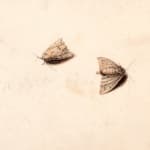Master of the Arundel Sketchbook
The present drawing was once part of a collection of twenty-five works owned by the Earl of Arundel. According to Horace Walpole, these drawings were created by Wenceslaus Hollar (1607-1677) at the Earl’s request, a belief likely stemming from a 19th-century inscription on the album’s frontispiece: “These drawings were done by Hollar for the Earl of Arundel, from whose Collection they were taken”.[1] In 1818, the album appeared in a single-owner sale, featuring hundreds of prints by Hollar from the collection of John Towneley, a noted collector with a particular passion for Hollar’s work.
When the album resurfaced in 1965, it was attributed Flemish School, middle of the 17th century. It was acquired by the London Alfred Brod Gallery, which disbanded the sketchbook, dispersing the drawings into the art market.[2] Some of the drawings were reattributed to the Master of the Arundel Sketchbook, abandoning the earlier association with Hollar.
Tying the album to the Earl of Arundel and Hollar, though perhaps anecdotal, suggests that at the time, these drawings were believed to have been created by the same hand and originated from a single source. One of the drawings, The Brown Aeshna and a small Tortoiseshell Butterfly, bears a partial foolscap watermark, aligning with Hollar’s period of activity in England and the Low Countries around 1640, further supporting the connection.
Born in Prague, Hollar studied under Matthaus Merian in Frankfurt. His first book of etchings was published in 1635 in Cologne. The following year, Hollar caught the attention of the esteemed art collector, the Earl of Arundel, and joined his household, eventually settling in England in 1637. Hollar travelled through Germany in Arundel’s service and later followed him to Antwerp. Based in Antwerp from 1644 to 1655, at the peak of his prolific career, Hollar produced a series of twelve etchings of flies, beetles, and worms, all depicted from life from the Arundeliana collection in Antwerp in 1646. The original source material likely came from the preserved specimens in Arundel’s cabinet of curiosities, which he had taken with him to Flanders, although some of the etchings suggest that Hollar studied his subjects from life. It has long been assumed that Hollar was merely the etcher, while another artist, influenced by Joris and Jacob Hoefnagel, likely created original color drawings. The only drawings associated with this set are those attributed to the Master of the Arundel sketchbook although none of the motifs can be directly linked to Hollar’s prints.
Two of the drawings from the Arundel sketchbook, A Turkey and a Great Green Bush Cricket, are now in the Metropolitan Museum of Art, New York, while three others are in the collection of Harvard Art Museums. Although the original album no longer exists, the images presented in the order of the 1965 sale attempt to reconstruct the album, encouraging further scholarship and research into these attributions.
[1] The leather bound album without the drawings is kept in a private collection, Waban, MA and was made accessible for study
[2] Franklin W. Robinson, Dutch Drawings from the Abrams Collection, Wellesley College, 1969, cat.no. 33
Provenance
Thomas Howard, 2nd Earl of Arundel (1586-1646)
John Towneley (1731-1813), Chiswick
Towneley collection of Hollar’s, King, London, 26-30 May 1818, lot 528 (the full album as by Wenceslaus Hollar)[1]
William Marmaduke, 25th Baron Mowbray, 26th Baron Seagrave and 22nd Baron Stourton, M.C. (1894-1965)
The Late Lord Mowbray and Stourton, Sotheby’s, London, 1 July 1965, lot 163 (the full album as Flemish school, middle of the 17th century), sold to
Alfred Brod Gallery, London, from whom acquired
Abraham Sebastian Nolst Trenité (1925-?), Rotterdam, The Netherlands, by descent
Private collection, The NetherlandsExhibitions
New York, Paul Kasmin Gallery, Naturalia, 19 January - 4 March 2017Literature
Horace Walpole, Anecdotes of Painting in England, Vol. 5, 1828, p. 105 (the full album as by Wenceslaus Hollar)Mark Stocker, Julia Kasper & Phil Sirvid, “Wenceslaus Hollar’s Muscarum scarabeorum vermiumque varie figure Anatomized and Identified”, Print Quarterly, XXXVI (2019) no. 4, pp. 393-395



